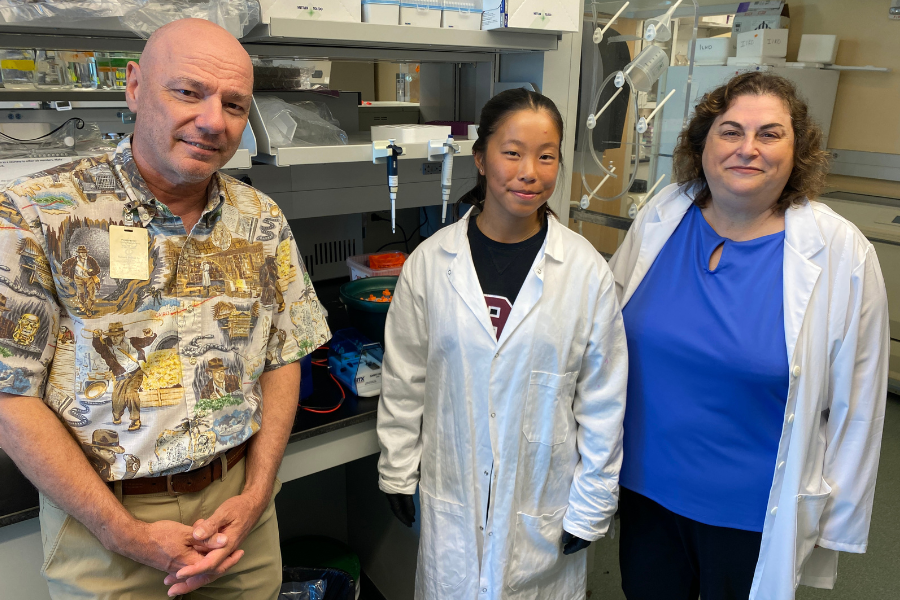
While diabetes is an epidemic in the United States, the burden weighs heavily in Hawaiʻi as 10 percent of our population is living with diabetes, according to the American Diabetes Association (ADA). Meanwhile, the ADA reports that 37 percent of the population in Hawaiʻi is living with pre-diabetes. With nearly half of our adult population impacted by diabetes in some way, the University of Hawaiʻi John A. Burns School of Medicine (JABSOM) created the Diabetes Research Center to perform cutting-edge research on a disease that impacts so many in Hawaiʻi. The National Institutes of Health (NIH) funded Phase 1 of the research in 2017 for $11.3 million and renewed the grant with $11.7 million for another five years.
"Living in Hawaiʻi, many of us have diabetes or know someone who has it, so it is our obligation as researchers in Hawaiʻi to investigate problems that affect the people of this state," said Dr. Mariana Gerschenson, Associate Dean for Research and Professor at the JABSOM. Dr. Gerschenson is also the Director of the Diabetes Research Center. "The renewal of this grant allows us to continue to do this critical research, and we are excited about starting Phase 2 of this research, which will explore the impact diabetes has on other parts of the body," she said.
When the NIH first funded the Centers of Biomedical Research Excellence (COBRE), the JABSOM created the Diabetes Research Center. Using cell and animal models, researchers conducted experiments to understand the mechanisms of how diabetes and pre-diabetes develop. The grant also allowed the JABSOM, the University of Hawaiʻi Cancer Center, and the College of Engineering at the University of Hawaiʻi at Mānoa to train five young investigators who have remained in Hawaiʻi and continue researching and teaching.
"This is a very exciting time for us to have the opportunity to give young people in Hawaiʻi an opportunity to study this abundant disease and its complications here at home," said Dr. Majorie Mau, the Center's Deputy Director and Professor in the Department of Native Hawaiian Health.
Phase 2 of the Diabetes Research Center will focus on complications from diabetes. Researchers will specifically look at how diabetes can trigger stroke and heart disease and impact the kidneys.
Some of the work done at the Diabetes Research Center studies the Native Hawaiian and Pacific Islander communities, which suffer from diabetes at a disproportionate rate compared to other populations.
"This Center will look at how the diverse populations in Hawaiʻi are affected by diabetes complications," Dr. Mau said. "The science that we do is completely relevant to the population here. We have an opportunity to take this unique environment and translate it and transform it, not just for our population here, but throughout the Pacific and very relevant globally."
Dr. Gerschenson assembled an all-star faculty team to investigate complications arising from diabetes.
Kathryn Schunke, PhD, Assistant Professor at JABSOM's Department of Anatomy, Biochemistry, and Physiology, is studying diabetic cardiomyopathy, one of the most prevalent complications in diabetics.
"Diabetic cardiomyopathy occurs when the brain doesn't signal to the heart appropriately," Dr. Schunke explains. "It can lead to life-threatening complications. We are working on a therapy targeted to the brain to decrease mortality in people with diabetes with this complication."
Dr. Stacy Brown is a physician-scientist and an Assistant Professor in the Department of Medicine. She is studying the genetics of diabetes and stroke in Native Hawaiians and Pacific Islanders in the Multiethnic Cohort Study.
Noemi Polgar, PhD, from JABSOM's Department of Anatomy, Biochemistry, and Physiology is investigating how the skeletal muscle transports glucose. The muscle is responsible for over 80 percent of sugar uptake after eating.
"We were the first to describe a certain aspect of this trafficking mechanism that contributes to sugar uptake after a meal," Dr. Polgar said.
Collaboration across other branches of science is another aspect of the research. Dr. Tyler Ray from UH Mānoa's College of Engineering is working on developing wearable technology, like sweat sensors, which can monitor kidney function.
The grant renewal will also boost the economy. The United for Medical Research report shows that $2.64 is added to the economy in Hawaiʻi for every dollar the medical school gets in grants. Like Phase 1, funding will also go towards developing another group of investigators who will research and teach the next generation of scientists.
"The purpose of the COBRE is to foster young investigators, so we are recruiting new faculty to work on diabetes. That money stays within the local economy. It funds young faculty, postdoctoral fellows, graduate students, medical students, undergraduate students, and support staff, so it contributes to the education mission of the medical school," said Dr. Olivier Le Saux, Professor and a senior investigator at the Center from JABSOM's Department of Cell and Molecular Biology.